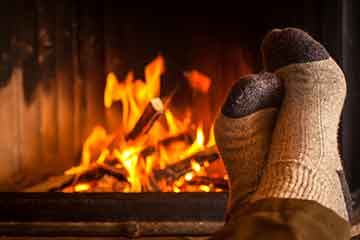Contact
Associate Professor of Air Quality
Phone: (479) 575-4862
Fax: (479) 575-2846
Email: yliang@uark.edu
University of Arkansas System Division of Agriculture
Cooperative Extension Service
2301 S. University Avenue
Little Rock, AR 72204
Heating with Firewood - Fireplace Safety and Health Tips
When comparing heating fuels, wood has a lot of advantages. If properly used, wood is an excellent fuel source. But if used improperly, heating with wood can put our health, our homes, and our environment at risk.

mail and glossy paper in your fireplace.
The key to making the most of heating with wood is proper:
- harvesting
- storage
- burn
- equipment maintenance
All of the above are key to keeping your indoor air quality healthy.
What is safe to burn in your fireplace?
Burn only Seasoned Wood!
Seasoned wood is wood that has been properly dried for at least six months and has a moisture content of 20 percent or less.
- When the firewood has dried in the sun and summer breezes, move it to a winter storage area that is dry and sheltered from rain.
- Seasoned wood burns more efficiently, resulting in better burning and less particulate matter emissions.
Fireplaces and wood stoves are designed to safely contain wood-fuel fires, while providing heat for a home.
Chimneys expel the by-products of combustion, which include smoke, water vapor, gases, unburned wood particles, hydrocarbon and other minerals. As these substances exit the fireplace or wood stove and flow into the relatively cooler chimney, condensation occurs. The resulting residue that sticks to the inner walls of the chimney is called creosote.
Burning wet or green wood causes more creosote buildup in your stovepipe.
Creosote is a tar-like substance consisting of oils that didn't completely burn in the wood stove. These oils can condense on the pipe and become a serious fire hazard. As the creosote builds up, it can ignite, causing a chimney fire.
Should I burn wet wood?
Burning fresh or wet wood is not efficient because so much energy is used initially just to drive off the water trapped in the cells of the logs. The resulting exhaust air is cooler than if seasoned wood is used.
What kind of wood should I burn?
What should I NOT burn in my fireplace?
Except for a small amount of newspaper to start a fire, never burn anything other than seasoned firewood in a wood stove. DO NOT BURN:
- junk mail
- bills
- glossy magazine pages
- wet or rotting wood
All of the above items burn poorly and release high levels of particulate matter, which can enter your lungs but can't escape. This can cause many health problems, including asthma and other respiratory diseases and cardiac issues.